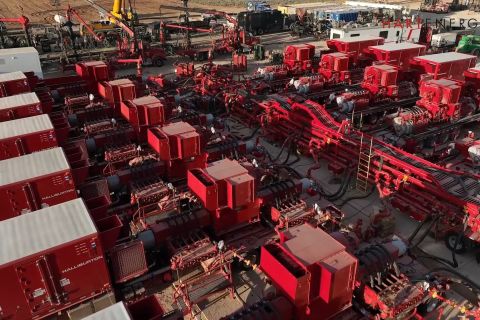Pemex has been moderately successful in its debut of its unique multiple-service contracts (MSCs) in northeastern Mexico's Burgos Basin. With six of the seven tenders now completed, the national oil company has met about half of its original goals. It received bids on four of the six blocks offered to date, netting commitments of nearly $4 billion. The bids were taken at intervals beginning in mid-October, and bids for the seventh block, Olmos, will be accepted on January 14. That block has a ceiling price of $345 million. Under the MSC structure, a company bids a discount to the Pemex price schedule to win a contract. The winning bidder then develops the block, and Pemex reimburses the company based on the production of gas from the block. Nineteen companies, including multinational firms, national oil companies and local operators and service companies, purchased data packages on the seven blocks. The first MSC contract was won by Spanish major Repsol YPF, which bid $2.4 billion to develop the Reynosa-Monterrey Block. The 1,244-square-mile block was the largest concession offered. In early 2004, Repsol plans to shoot 270 square miles of 3-D seismic and drill eight exploration wells. During the next three years, it will invest $172 million in the block, which contains 16 gas fields and is currently producing 14 million cubic feet of gas per day. By 2007, it expects the block to be producing 70 million cubic feet per day. A second MSC was awarded to a multinational consortium comprised of Petrobras, Teikoku Oil Co. Ltd. and D&S Petroleum, a unit of Mexican firm Grupo Diavaz. The partners offered $260 million for the rights to drill on the Cuervito Block, located directly across the Texas border in Nuevo Leon. One of the smallest blocks in the tender, it covers 89 square miles. The third block, Mision, was won by Argentina-based TecPetrol, a unit of Italian firm Techint Group, and Mexican service company Industrial Perforadora de Campeche. The pair bid $1.04 billion for the right to develop the medium-size MSC, which covers 761 square miles in Nuevo Leon and Tamaulipas states. Mision contains 21 gas fields currently producing 35 million cubic feet per day, and the partners plan to raise output by 91 million cubic feet of gas per day. Each of the first three blocks had a lone bidder. The fourth and fifth blocks, Corindon-Pandura and Ricos, were among the largest in the tender and received no bids, however. Pemex had set a ceiling of $3.56 billion on the bidding for Corindon-Pandura. Two companies-Total and Repsol-had acquired the data package for the block, but neither offered a commitment. Ricos had a ceiling of $2 billion, and although ExxonMobil and Total bought data packages, neither placed a bid. On Fronterizo, the sixth block, Pemex received two bids. On technical grounds, Pemex rejected a bid from a consortium comprised of Houston-based service company Amistad Energy, a subsidiary of China National Petroleum Corp. and Chinese company Tiainjin Dagang Shengkang Petroleum Technology Development Co. Pemex reported that the group did not furnish all the required documentation. The second bid, which was accepted, came from the Petrobras-Teikoku-D&S Petroleum group that won the Cuervito Block. The consortium pledged $265 million to drill 100 wells and raise production to 34 million cubic feet a day on the 90-square-mile block. The term of this contract is 15 years. Pemex says production from the four Burgos MSC blocks that have been tendered to date will reach 400 million cubic feet a day, with investments close to $4 billion. It expects to save $750 million on what it would have spent if it extracted the gas itself. Pemex's original goal for the MCS contracts was to raise production in the Burgos Basin by 1 billion cubic feet of gas per day, with investment levels of between $8 billion and $10 billion. Not placing the Corindon-Pandura and Ricos blocks was certainly a blow, as they together cover some 2,300 square miles and accounted for more than 50% of the value ascribed to the initial MSC round. Pemex has indicated that it may split these blocks into smaller units before tendering them again, broadening their appeal to mid-size companies. (For more on Mexico, see the July 2003 issue.)
Recommended Reading
CERAWeek: Large Language Models Fuel Industry-wide Productivity
2024-03-21 - AI experts promote the generative advantage of using AI to handle busywork while people focus on innovations.
Cyber-informed Engineering Can Fortify OT Security
2024-03-12 - Ransomware is still a top threat in cybersecurity even as hacktivist attacks trend up, and the oil and gas sector must address both to maintain operational security.
Exclusive: Halliburton’s Frac Automation Roadmap
2024-03-06 - In this Hart Energy Exclusive, Halliburton’s William Ruhle describes the challenges and future of automating frac jobs.
Oil States’ ACTIVEHub for Digitized Assets
2024-03-14 - Oil States Energy Services’ new ACTIVEHub system and ACTIVELatch help operators remotely monitor and automate frac locations for a more efficient and safer wellsite.




